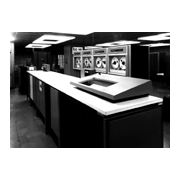In April 1963, NEC announced the NEAC-2400, 3400, 2800 and 3800, which were developed by introducing technology from Honeywell (USA). NEC concluded a licensing agreement with Honeywell in July 1962, and they were the series of electronic computers produced as the first result of that technology adoption, were made in accordance with uniform design policies for both hardware and software, and had complete compatibility. In the computers in this series, cascade processing of data input, sorting, calculation and output of results could be done in a consistent, extremely high-efficiency, easy manner. In other words, the system used arithmetic circuits, core memory, magnetic tape units and input/output devices (such as card punches and readers) which were top-class for the time in terms of speed.
The distinguishing feature of this series was the fact that it allowed simultaneous processing. Program interrupts and priority processing were possible with the NEAC-2400 and 3400, and the NEAC-3400 used a mechanism with card memory to enable arithmetic operations even during data transfer time. In the NEAC-2800 and 3800, it was possible to conduct all peripheral device operation and internal arithmetic simultaneously and in parallel. The biggest feature of these two models was the fact that they had multiplexed processing capability, and could execute multiple programs independently and in parallel.
| Model name | NEAC-2400 | NEAC-3400 | NEAC-2800 | NEAC-3800 |
|---|---|---|---|---|
| Announcement date | April 1963 | |||
| Size | Mid-size/Small | Mid-size | Large | Ultra-large |
| Number of A+B->C operations per sec |
10,000 | 14,000 | 30,000 | 90,000 |
| 12 digit memory cycle time | 8.5µs | 13µs | 6µs | 2µs |
| Internal memory capacity (words) | 4,096 | 16,384 | 32,768 | 65,536 |
| Number of usable magnetic tape drives | 8 | 16 | 64 | |
| Number of usable Line printers | 1 | 2 | 8 | |


